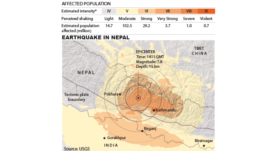Originally posted in VOA by Steve Herman, Anjana Pasricha
KOLKATA, INDIA — International rescue and relief teams are converging on Nepal’s capital, Kathmandu, even as hopes fade that more survivors will be found in the aftermath of a massive quake Saturday that has claimed more than 3,700 lives.
The capital’s airport was so congested with military planes attempting to land that a flight carrying 70 members of Japan’s national search-and-rescue team circled futilely and eventually had to be rerouted to Kolkata for refueling.
 Earthquake in Nepal, map showing epicenter, April 27, 2015
Earthquake in Nepal, map showing epicenter, April 27, 2015A second attempt also proved futile, and the plane flew back to Kolkata. Once on the ground, the 292 passengers were told that all available hotel rooms in Kolkata were taken and the flight would return to Bangkok, where it had originated.
Nepali passengers on the plane said they had received text messages from those at Kathmandu airport informing them of a chaotic situation there, with Indian nationals overwhelming the facility, hoping to get on evacuation flights.
The U.S. Geological Survey expects further moderate tremors in the area this week. Ongoing aftershocks pushed Kathmandu residents to sleep in the streets for a third night Monday, fearing further structural collapse. Some huddle under tents, tarps or other improvised shelters.
Huge tented camps are springing up in Nepal’s main towns, but similar assistance has yet to reach remote areas.
Fears of shortages, disease loom
More than 48 hours after the magnitude 7.8 earthquake shook Nepal, rescue teams are scrambling to reach those who need aid, amid looming fears of epidemics and mounting shortages of food and water.
Nepal’s chief secretary, Lila Mani Poudyal, appealed again for urgent help from the international community, saying they need everything from dry goods to tents and paramedics to expert teams to cope with the aftermath.
Citing Nepali government sources, the United Nations said 35 of the country’s 75 districts are affected. Some 30 million people live in Nepal.
UNICEF says nearly 1 million children need the agency’s assistance.
It is the worst disaster in living memory for most Nepalese. On Monday, distraught people prayed and waited for news of their loved ones as rescuers used everything from pickaxes to bare hands to sift the rubble.
A young couple in Kathmandu told reporters they were out of the house Saturday when the quake struck, and they still didn’t know the fate of the two young children they’d left at their home, now buried. The father waited on mounds of rubble, saying he wants to find his children, dead or alive.
Nepal’s capital and other towns all have such heart wrenching stories. Mass cremations were conducted on Monday as the death toll continued to rise.
Oxfam executive Helen Szoke told VOA the earthquake has given Nepal what she described as a “double hit.” She said the country’s destroyed infrastructure will not support the tourism industry that Nepal depends on, compounding the humanitarian tragedy.
Hospitals inundated
Hospitals in the Kathmandu area have been overwhelmed with the more than 6,500 people who have been injured.
“There are a lot of patients who have got a devastating injury, including head as well as the amputation of the limbs, whole limb amputations. A lot of devastating injuries including chest, badly chest injuries,” said Dr. Ganesh Gurung, vice counselor of the National Academy of Medial Science.
Communications systems from rural areas have been knocked out and landslides have likely cut off many villages. The death and injury tolls are expected to rise when word comes in from those areas.
On a website established by the International Committee of the Red Cross, hundreds of Nepalis and foreigners are reported missing by their loved ones. Far fewer have checked in on the site to report they are alive.
Disaster response teams arriving
Disaster response teams from various countries, including the United States, have deployed to the region to help search, rescue and recovery efforts.
India’s foreign secretary, Subrahmanyam Jaishankar, said three tons of supplies and 40 members of India’s National Disaster Response Force were flying to Nepal. The country is also evacuating its nationals by air.
India’s foreign secretary, Subrahmanyam Jaishankar, spoke of heavy traffic on highways leading to Kathmandu, saying that while roads are open, “the traffic is moving very slowly. It is clogged with vehicles … we are trying to piece together the picture, but it is a very, very difficult situation.”
China, Germany, Canada and Israel are among the countries also sending disaster personnel to the area.
Saturday’s earthquake was the strongest in 81 years in Nepal, when an even mightier jolt in 1934 killed more than 10,000 people.
Photo credit: By Krish Dulal (Own work)
[CC BY-SA 4.0 (http://creativecommons.org/licenses/by-sa/4.0)], via Wikimedia Commons

![By Krish Dulal (Own work) [CC BY-SA 4.0 (http://creativecommons.org/licenses/by-sa/4.0)], via Wikimedia Commons](https://www.relief.asia/wp-content/uploads/2015/04/Nepal_Earthquake_2015_01-1038x576.jpg)